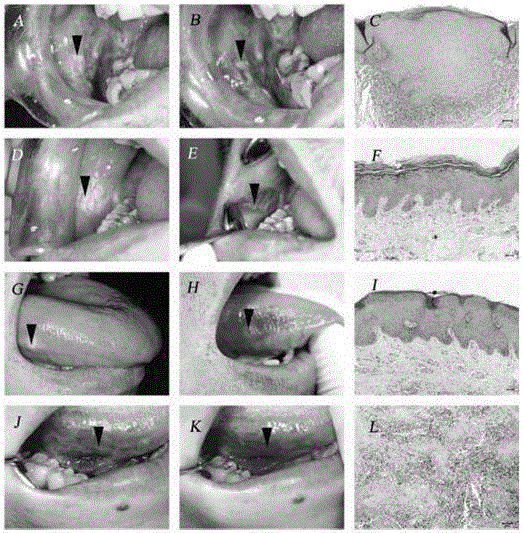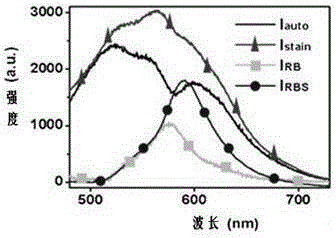Kit for benign lesion identification and malignant lesion detection of oral mucosa and detection method thereof
A detection kit and oral mucosa technology, which are applied in the field of benign lesions investigation and malignant lesion detection kits of oral mucosa, can solve problems such as affecting early diagnosis, difficult for early introduction of patients, and promoting transfer.
- Summary
- Abstract
- Description
- Claims
- Application Information
AI Technical Summary
Problems solved by technology
Method used
Image
Examples
Embodiment 1
[0034] (1). Oral examination, record the details of the lesion;
[0035] (2). Gargle with clean water to remove food residues;
[0036] (3). Take the pre-test reagent and rinse for 1 to 5 minutes;
[0037] (4). Dip the detection reagent 1 with a cotton swab and rub it on the lesion, and stain for 2 to 10 minutes;
[0038] (5). Take the detection reagent 2 and rinse for 1 to 5 minutes;
[0039] (6). Semi-quantitative or quantitative evaluation of staining results by comparison with color guides or auto-excited fluorescence detection instruments.
[0040] The phosphate buffer mentioned above is 0.01M, and the preparation method is as follows:
[0041] Weigh 7.9gNaCl, 0.2gKCl, 1.44gNa2HPO4 and 1.8gK at a temperature of 0-4°C 2 Dissolve HPO4 in 800ml of distilled water, adjust the pH value of the solution to 7.4 with HCl, and finally add deionized water to make it up to 1L, and store it in a refrigerator at 4°C for later use.
[0042] The preparation method of the above-menti...
Embodiment 2
[0045] (1). Oral examination, record the details of the lesion;
[0046] (2). Gargle with clean water to remove food residues;
[0047] (3). Take the pre-test reagent and rinse for 1 to 5 minutes;
[0048] (4). Dip the detection reagent 1 with a cotton swab and rub it on the lesion, and stain for 2 to 10 minutes;
[0049] (5). Take the detection reagent 2 and rinse for 1 to 5 minutes;
[0050] (6). Semi-quantitative or quantitative evaluation of staining results by comparison with color guides or auto-excited fluorescence detection instruments.
[0051] The phosphate buffer mentioned above is 0.01M, and the preparation method is as follows:
[0052] At a temperature of 0-4°C, weigh 7.9gNaCl, 0.2gKCl, 0.24gKH 2 PO4 and 1.8gK 2 Dissolve HPO4 in 800ml of distilled water, adjust the pH value of the solution to 7.4 with HCl, and finally add deionized water to make it up to 1L, and store it in a refrigerator at 4°C for later use;
[0053]The preparation method of the above-men...
PUM
 Login to View More
Login to View More Abstract
Description
Claims
Application Information
 Login to View More
Login to View More - R&D
- Intellectual Property
- Life Sciences
- Materials
- Tech Scout
- Unparalleled Data Quality
- Higher Quality Content
- 60% Fewer Hallucinations
Browse by: Latest US Patents, China's latest patents, Technical Efficacy Thesaurus, Application Domain, Technology Topic, Popular Technical Reports.
© 2025 PatSnap. All rights reserved.Legal|Privacy policy|Modern Slavery Act Transparency Statement|Sitemap|About US| Contact US: help@patsnap.com



